Acute. Later, community
In 1838 the Epping Union opened a purpose-built workhouse to the northeast of the town. The buildings housed 220 inmates and had cost £6,000.
In 1846 a separate 2-storey infimary was added. It became the laundry when a new infirmary was built to the south of the main workhouse building in 1876.
During the 1880s major building works were carried out, including remodelling of the entrance block at the north of the site. New buildings were added to the west, and the southern wing of the workhouse was replaced with a dining hall and a chapel, and another new infirmary.
In 1913 yet another infirmary was built to the east of the workhouse. During WW1, between 1917 and 1919, this infirmary was requisitioned by the Army Council for use as a military hospital.
In 1930, following the abolition of the Boards of Guardians, control of the workhouse and its infirmaries passed to the Essex County Council, as the Epping Public Assistance Institution (PAI).
In 1938 the PAI was renamed St Margaret's Hospital (the Chairman of the House Committee, who had also been one of the Guardians, had been Miss Margaret Mathieson, and it was suggested that the Hospital be named after her).
During WW2 the Hospital joined the Emergency Medical Service (EMS) as an Advanced Base. The facilities were upgraded; hutted wards and a Nurses' Annexe were built. The Hospital then had 654 beds.
In March 1945 the water tower in Fairfield Road received a direct hit from a V2 rocket. The resulting explosion killed seven men at the Hospital.
The Hospital joined the NHS in 1948, belonging to the Epping Group Hospital Management Committee, part of the North East Metropolitan Regional Hospital Board. It still had its EMS beds in the hutted wards, and a small portion of the premises in the former workhouse remained reserved for 'casual wayfarers'. However, the National Assistance Board agreed to the closure of this section.
By 1950 new Out-Patients and Casualty Departments had been established in an adapted EMS hut. An appointments system was introduced for out-patients. An adjacent ward was converted into a modern and well-equipped Pathology Laboratory, which undertook work for the whole Epping Group of hospitals. A modern maternity unit with 32 beds was housed in adapted EMS wards; the unit also had 4 private patient rooms at a cost of £12 8s 6d (£12.42) a week. However, the new X-ray Department, with a new unit and a portable machine, was already considered far too small.
In March 1950 the Hospital had 487 beds, of which 387 were staffed; 110 of these were for chronically sick patients. The Hospital treated general medical, surgical, maternity and gynaecological cases, as well as those with TB. The lack of accommodation for resident nursing and domestic staff meant that the EMS Nurses' Annexe had to be adapted to accommodate 24 extra bedrooms. In October 1950 a GP unit of 7 beds opened, staffed by the GPs from Epping and District Cottage Hospital, which had become a Nurses' Home.
In 1951 the Hospital had 485 beds. Clinics were established for orthopaedic and paediatric cases. In October the Matron accepted responsibility for Honey Lane Hospital. In the same month the operating theatre and the X-ray Department were closed for extension and the installation of new equipment. They re-opened in February 1952. (However, during the early 1950s radiographic work was curtailed because of an acute shortage of X-ray film.)
In 1952 the Ministry of Health bought The Limes, a large private house adjacent to the Hospital, for £8,400, to be used as a Nurses' Home to house 27 nurses. In the following year, another large house nearby - Ivylands - was bought for £7,795 for additional staff accommodation. The Hospital roadways were repaired and resurfaced. The No. 20 bus service was extended to run to the Hospital, where there was a concrete bus stand just outside the main entrance.
In 1953 the wartime gas-cleansing station was adapted for use as an ante- and postnatal clinic. The Hospital had 482 beds, of which 415 were open.
In a joint arrangement with Essex County Council, the Hospital still accommodated 60 aged, non-sick residents under Part III of the National Assistance Act, 1948. With the building of the Debden Estate by the LCC and the development of Harlow New Town, the Hospital was coming under pressure. It desperately wanted to rid itself of the 'Part III-ers', who did not need hospital care but did not have anywhere else to go.
In 1955 the kitchen was extended. The foundations of the boiler house had sunk and needed renewing. The work had to be carried out during the winter months, necessitating the use of a temporary Cochran boiler. The old boiler was reinstalled along with a new one, at a cost of £15,200.
During the 1950s the Hospital was progressively modernised. A new Out-Patients Department was built during 1956 and 1957 to replace that in the EMS hut. It was to be located between B Block (the only permanent brick-built ward accommodation in the Hospital) and Cherry Ward, necessitating the demolition of the 40-bedded TB pavilion (once only used for male patients, but now occupied by both sexes). The TB patients were transferred to Honey Lane Hospital. The Part III inmates in B Block were to be moved (discussion about their future was underway between the Regional Hospital Board and Essex County Council), as well as the Nurses' Preliminary Training School and Teaching Unit, thus freeing two ward spaces.
In January 1956 the Epping Group administration moved into Oak Cottage, which was adjacent to the Hospital and had been purchased for £6,651 and converted for the purpose. The former offices in the Hospital were then made into accommodation for the resident medical staff, while theirs, on the second floor of B Block, became nursing staff accommodation. A plot of land next door to Oak Cottage was sold to Essex County Council for an ambulance station.
The catchment area of the Epping Group now contained some 125,000 people, but when Harlow Town was completed the number would rise to 160,000. Bed occupancy at the Hospital was 85%, including an increasing number of admissions from industrial and road traffic accidents. A new Casualty Department was planned to deal with this increase.
Under the terms of agreement with Essex County Council, the Hospital Management Committee was obliged to provide temporary accommodation for 7 female members of evicted families. The Hospital asked that this obligation be terminated as soon as possible, as the presence of these people on Hospital premises was against its interests.
Curtained cubicles were provided in the main wards of the Hospital (previously portable screens had been used to provide privacy). A new switchboard was installed and a staff location system - the Multitone Personal Call Staff Location System was the one chosen.
The Hospital had advertised for a dietician in 1956, but had received no applications.
In July 1956 Princess Alice, Countess of Athlone visited the Hospital for the nurses' prize-giving ceremony. In July 1957 the prize-giving was performed by the Countess Mountbatten of Burma. The nursing staff at this time were living in six different premises - the main Nurses' Home, which had been erected pre-war, and the Nurses' Home Annexe, added for the extra staff needed for the EMS wards, The Limes, Ivylands, Epping and District Cottage Hospital and the top floor of B Block.
During the flu epidemic in October 1957, staff levels had fallen to a dangerous low. Work had begun to extend the X-ray Department in October 1957 (it was completed in the autumn of 1958), but during this period there was a nationwide shortage of radiographers.
In January 1958 Larch Ward, which had been used previously for 20 TB patients, became the children's and women's surgical ward. In February a Hearing-Aid Repair Centre was established, opening for one session a week.
In 1958 central heating was installed in the hutted wards and the coke-fired stoves scrapped. The services of the hot water boiler attendants, who had been employed on maintaining fuel supplies and stoking stoves, were dispensed with. The covered way linking the wards and departments was enclosed, so that it was weather-proof. The old hand-painted ward and department signs were replaced with glass illuminated ones. An Occupational Therapy Department was established in an old woodshed and storeroom. A Recovery Room was built for theatre patients (previously they had had to be trundled back to their wards at some distance). The old part of the Hospital was rewired (the wiring had been 'condemned'). The wards for the Part III residents were improved, and the walls plastered. Specialist contractors had to be employed to treat the growth of fungus on the asbestos roofs of the main hutted wards, and the roofs were then redecorated. The 34-bedded maternity unit had to be closed for a prolonged period as its floor was found to be defective, but the patients were moved to an empty ward. During 1958 bed occupancy was 90%.
By 1972 the Hospital had 422 beds, mainly for acute and maternity patients. In 1974, following a major reorganisation of the NHS, control of the Hospital was transferred to the Harlow District Health Authority, part of the North East Thames Regional Health Authority.
In 1982, after another NHS reorganisation, it came under the control of the Essex Area Health Authority. It had 309 beds.
By 1991 it had 286 beds. Following yet another reorganisation of the NHS and the introduction of the Trust system, the Hospital came under the control of the West Essex Primary Care Trust.
In May 1998 the original workhouse building, which had been used for administrative offices, was vacated (it was demolished in 2001).
In 2005 work began to redevelop the Hospital. Most of the site, containing many old redundant buildings and the EMS huts, was sold to Bellway for redevelopment, while new hospital premises were built under a Private Finance Initiative deal funded by Ryhurst.
The new building at the northwest of the remaining site was named the Epping Forest Unit. It
was completed in 2007 at the cost of £13.4m. (It was
officially opened by the then Health Secretary, Alan Johnson, in July 2008.)
Present status (June 2008)
The Hospital has now become St Margaret's Community Hospital. Various old buildings survive and are used as clinics and offices. The Epping Forest Unit contains state-of-the-art healthcare facilities for out-patients, a Day Hospital and 60 beds for elderly in-patients.
It is also the headquarters for NHS West Essex (previously West Essex Primary Care Trust).
Some 5.56 hectares of the Hospital site, where the EMS huts were located, has been redeveloped by Bellway and now is now Kings Wood Park, a housing estate.
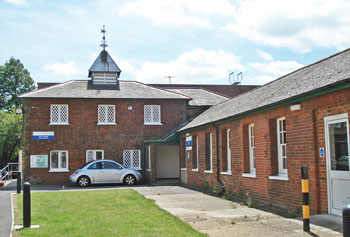
The Grade II listed laundry building, just to the south of the Epping Forest Unit, is now The Laurels.
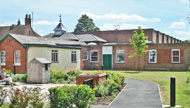
Various old buildings still remain, although much altered over the years. Most of them are named after trees.
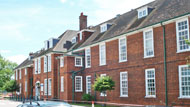
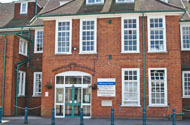
Birchwood House, the former infirmary, is at the east of the site.

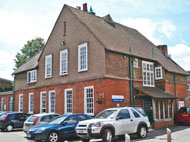
Maple Lodge (left) and Hawthorn Lodge (right) are towards the south of the site.
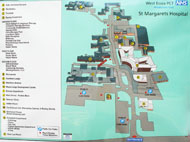
The site plan of the Hospital (the south is at the top).
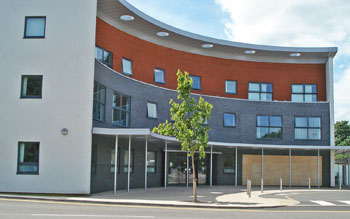
The Epping Forest Unit contains Plane and Poplar Wards, for the rehabilitation of elderly patients, and Beech Ward for stroke and neurological patients.
The first casualties had been expectant mothers from the East End of London evacuated to Spriggs Oak in Palmers Hill. A bomb fell on the house in October 1940, killing six and injuring two more, who later died at St Margaret's Hospital. The second incident in 1945 (mentioned above) killed seven men at the Hospital.
www.fylde.demon.co.uk
www.flickr.com
St Margaret is the patron saint of childbirth. Herself a virgin, she promised women that they would come to no harm if they called on her. |
http://seax.essexcc.gov.uk
http://unlockingessex.essexcc.gov.uk
www.british-history.ac.uk
www.geograph.org.uk
www.westessexpct.nhs.uk
www.workhouses.org.uk
Return to home page